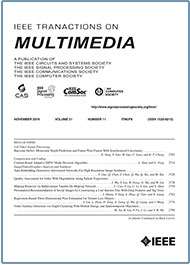- Our Story
- Publications & Resources
- Publications & Resources
- Publications
- IEEE Signal Processing Magazine
- IEEE Journal of Selected Topics in Signal Processing
- IEEE Signal Processing Letters
- IEEE Transactions on Computational Imaging
- IEEE Transactions on Image Processing
- IEEE Transactions on Information Forensics and Security
- IEEE Transactions on Multimedia
- IEEE Transactions on Signal and Information Processing over Networks
- IEEE Transactions on Signal Processing
- IEEE TCI
- IEEE TSIPN
- Data & Challenges
- Submit Manuscript
- Guidelines
- Information for Authors
- Special Issue Deadlines
- Overview Articles
- Top Accessed Articles
- SPS Newsletter
- SigPort
- SPS Resource Center
- Publications FAQ
- Blog
- News
- Dataset Papers
- Conferences & Events
- Community & Involvement
- Professional Development
- For Volunteers
- Information for Authors-OJSP
-
Home
Conferences Events IEEE Signal Processing Magazine IEEE SPL Article IEEE TIFS Article IEEE TMM Article IEEE TSP Article Jobs in Signal Processing Lectures Machine Learning Seasonal Schools Signal Processing News SPM Article SPS Distinguished Lectures SPS Newsletter Article SPS Webinar SPS Webinars SPS Webinar Series Webinar webinars
-
Our Story
What is Signal Processing?

The technology we use, and even rely on, in our everyday lives –computers, radios, video, cell phones – is enabled by signal processing. Learn More » -
Publications & Resources
-
SPS Resources
- Signal Processing Magazine The premier publication of the society.
- SPS Newsletter Monthly updates in Signal Processing
- SPS Resource Center Online library of tutorials, lectures, and presentations.
- SigPort Online repository for reports, papers, and more.
- SPS Feed The latest news, events, and more from the world of Signal Processing.
-
SPS Resources
-
Conferences & Events
-
Community & Involvement
-
Membership
- Join SPS The IEEE Signal Processing Magazine, Conference, Discounts, Awards, Collaborations, and more!
- Chapter Locator Find your local chapter and connect with fellow industry professionals, academics and students
- Women in Signal Processing Networking and engagement opportunities for women across signal processing disciplines
- Students Scholarships, conference discounts, travel grants, SP Cup, VIP Cup, 5-MICC
- Young Professionals Career development opportunities, networking
- Get Involved
-
Technical Committees
- Applied Signal Processing Systems
- Audio and Acoustic Signal Processing
- Bio Imaging and Signal Processing
- Computational Imaging
- Image Video and Multidimensional Signal Processing
- Information Forensics and Security
- Machine Learning for Signal Processing
- Multimedia Signal Processing
- Sensor Array and Multichannel
- Signal Processing for Communication and Networking
- Signal Processing Theory and Methods
- Speech and Language Processing
- Technical Working Groups
- More TC Resources
-
Membership
-
Professional Development
-
Professional Development
- Signal Processing Mentorship Academy (SigMA) Program
- Micro Mentoring Experience Program (MiME)
- Distinguished Lecturer Program
- Distinguished Lecturers
- Distinguished Lecturer Nominations
- Past Lecturers
- Distinguished Industry Speaker Program
- Distinguished Industry Speakers
- Distinguished Industry Speaker Nominations
- Industry Resources
- IEEE Training Materials
- Jobs in Signal Processing: IEEE Job Site
-
Career Resources
- SPS Education Program Educational content in signal processing and related fields.
- Distinguished Lecturer Program Chapters have access to educators and authors in the fields of Signal Processing
- Job Opportunities Signal Processing and Technical Committee specific job opportunities
- Job Submission Form Employers may submit opportunities in the area of Signal Processing.
-
Professional Development
-
For Volunteers
-
For Board & Committee Members
- Board Agenda/Minutes* Agendas, minutes and supporting documentation for Board and Committee Members
- SPS Directory* Directory of volunteers, society and division directory for Board and Committee Members.
- Membership Development Reports* Insight into the Society’s month-over-month and year-over-year growths and declines for Board and Committee Members
-
For Board & Committee Members
Popular Pages
Today's:
- Information for Authors
- Submit Your Papers for ICASSP 2026!
- (ICME 2026) 2026 IEEE International Conference on Multimedia and Expo
- Submit a Manuscript
- IEEE Transactions on Multimedia
- IEEE Transactions on Information Forensics and Security
- IEEE Transactions on Image Processing
- Membership
- Information for Authors-SPL
- IEEE Transactions on Signal Processing
- (ICASSP 2026) 2026 IEEE International Conference on Acoustics, Speech, and Signal Processing
- Call for Papers for ICASSP 2026 Now Open!
- Signal Processing 101
- (ASRU 2025) 2025 IEEE Automatic Speech Recognition and Understanding Workshop
- Unified EDICS
All time:
- Information for Authors
- Submit a Manuscript
- IEEE Transactions on Image Processing
- IEEE Transactions on Information Forensics and Security
- IEEE Transactions on Multimedia
- IEEE Transactions on Audio, Speech and Language Processing
- IEEE Signal Processing Letters
- IEEE Transactions on Signal Processing
- Conferences & Events
- IEEE Journal of Selected Topics in Signal Processing
- Information for Authors-SPL
- Conference Call for Papers
- Signal Processing 101
- IEEE Signal Processing Magazine
- Guidelines
Last viewed:
- (EUSIPCO 2025) 2025 European Signal Processing Conference
- Our Members
- (ICASSP 2026) 2026 IEEE International Conference on Acoustics, Speech, and Signal Processing
- (ICME 2026) 2026 IEEE International Conference on Multimedia and Expo
- SPS Staff
- IEEE Transactions on Multimedia
- Unified EDICS
- Explainability in Graph Data Science: Interpretability, replicability, and reproducibility of community detection
- Students
- SPS Webinar: Presentation Attack Detection on ID Cards
- Information for Authors OJSP
- (ISBI 2025) 2025 IEEE International Symposium on Biomedical Imaging
- IEEE Signal Processing Letters
- Information for Authors
- Statistical and Deep Learning Schemes for Maritime RADAR Detection and Surveillance
The Interpretable Fast Multi-Scale Deep Decoder for the Standard HEVC Bitstreams
You are here
Transactions on Multimedia
Publications & Resources
For Authors
Top Reasons to Join SPS Today!
1. IEEE Signal Processing Magazine
2. Signal Processing Digital Library*
3. Inside Signal Processing Newsletter
4. SPS Resource Center
5. Career advancement & recognition
6. Discounts on conferences and publications
7. Professional networking
8. Communities for students, young professionals, and women
9. Volunteer opportunities
10. Coming soon! PDH/CEU credits
Click here to learn more.
The Interpretable Fast Multi-Scale Deep Decoder for the Standard HEVC Bitstreams
It is a research hotspot to restore decoded videos with existing bitstreams by applying deep neural network to improve compression efficiency at decoder-end. Existing research has verified that the utilization of redundancy at decoder-end, which is underused by the encoder, can bring an increase of compression efficiency. However, most existing research neglects the abundant multi-scale information among video frames as a typical type of such redundancy. It remains an interesting yet challenging topic how to build an effective, interpretable and fast deep neural network for the purpose of using the multi-scale similarity at decoder-end and further enhancing compression efficiency. To this end, this paper considers the use of underused inter multi-scale information and proposes the Fast Multi-Scale Deep Decoder (Fast MSDD) for the state-of-the-art video coding standard HEVC. The advantages of Fast MSDD are three-fold. First, it achieves a higher coding efficiency without modifying any encoding algorithm. Second, Fast MSDD is interpretable based on the framework of using the underused redundancy. Third, it guarantees the model's inference speed while fully using the multi-scale similarity among video frames. Extensive experimental results verify Fast MSDD's effectiveness, interpretability, and computational efficiency. Fast MSDD obtains averagely 14.3%, 10.8%, 8.5% and 7.6% BD gains for AI, LP, LB and RA respectively. Compared with our previous work MSDD, Fast MSDD achieves increases of 59.3%, 49.1%, 61.0% and 29.3%. Meanwhile, 16.9%, 11.2%, 9.2% and 8.3% BD gains are observed on videos with scale changes, which validate the interpretability of the proposed method. Furthermore, Fast MSDD can save at most 56.3% time compared to MSDD.
SPS Social Media
- IEEE SPS Facebook Page https://www.facebook.com/ieeeSPS
- IEEE SPS X Page https://x.com/IEEEsps
- IEEE SPS Instagram Page https://www.instagram.com/ieeesps/?hl=en
- IEEE SPS LinkedIn Page https://www.linkedin.com/company/ieeesps/
- IEEE SPS YouTube Channel https://www.youtube.com/ieeeSPS
Home | Sitemap | Contact | Accessibility | Nondiscrimination Policy | IEEE Ethics Reporting | IEEE Privacy Policy | Terms | Feedback
© Copyright 2025 IEEE - All rights reserved. Use of this website signifies your agreement to the IEEE Terms and Conditions.
A public charity, IEEE is the world's largest technical professional organization dedicated to advancing technology for the benefit of humanity.











